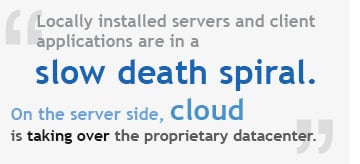
Have you ever noticed that industry analyst firms only cover technology that appears to be growing? Even though slow death is a viable trend, you can’t really put out a report that disparages several of your clients’ entire business models and expect to stay in business yourself. I would argue locally installed trading applications falls into this category.
Don’t mistake the business model for the business. When Jamie Dimon warned shareholders in a recent letter that “Silicon Valley is coming” he didn’t mean JP Morgan was going out of business. He was acknowledging that his business model had to change to create a more seamless experience and take advantage of new technology. In that same paragraph, Mr. Dimon also mentioned JPM was open to partnering, “where it makes sense.”
Trading application providers need to make the same two acknowledgements. Locally installed servers and client applications are in a slow death spiral. On the server side, cloud is taking over the proprietary datacenter. A good portion of my day is spent helping capital markets clients navigate cloud migration and product development. The level of activity is much higher than most people realize. It won’t be too many years before a salesperson showing up to pitch a non-latency sensitive application with actual server requirements gets shown the door.
 On the client side, HTML5 is the desktop replacement. There are no upgrades. No patches. No nothing but a reasonably current browser. Oh, and when you open it on a tablet or a mobile phone, it works there too. Couple HTML5 with cloud and your development cycles gets cheaper, faster, and more incremental. This is one of the reasons incumbent companies are being pushed to keep up. Granted, most of the FinTech activity driving change has been on the retail banking side, but don’t expect that to last.
On the client side, HTML5 is the desktop replacement. There are no upgrades. No patches. No nothing but a reasonably current browser. Oh, and when you open it on a tablet or a mobile phone, it works there too. Couple HTML5 with cloud and your development cycles gets cheaper, faster, and more incremental. This is one of the reasons incumbent companies are being pushed to keep up. Granted, most of the FinTech activity driving change has been on the retail banking side, but don’t expect that to last.
My friends at Trading Technologies are a great example of a company that knew they could not continue to scale and leverage opportunities without removing both the server and the desktop from their client requirements. The new SaaS platform (TT) will afford Trading Technologies the luxury of leverage. Companies like Trading Technologies can take advantage of all the technology advances occurring around their focus in areas like data analytics, visualization, software-defined networks, and containerization.
Partnering is another key feature of removing technology barriers. As more emerging companies establish themselves on like architecture and in some cases, in the same virtual environment, community-based applications become much more viable. Each partner can focus on their core competency while being relatively unconcerned about significant integration challenges. It also creates a plug-and-replace capability where firms leveraging the technology of one partner have a low barrier to replace that partner if a more suitable or advanced capability emerges.
In terms of partnerships, my friends at Tradier bet even bigger. They bet that they could create enough of a partner network that they didn’t need to build any client-facing technology. That bet appears to be paying off for them. The entire trading application is available via REST APIs so their partners integrate trading capabilities into user interfaces as they see fit.
My friends at Tradovate have taken this approach to active traders: a cloud infrastructure, a Javascript front-end, and a focus on core competency relying on partners to manage the periphery.
Each of these companies has another shared characteristic. They’re all run by people who have done this before and are leveraging the opportunity to do it better this time. I could list many more companies sharing these characteristics. If your company is making the bet that the desktop is here to stay and cloud is a passing fad, good luck to you. If I were still at an analyst firm, I’d never be allowed to create a negative CAGR chart on that bet, but you know I’d be thinking it.
Related Reading: Looking For A Futures Firm To Trade With? Top 5 Must Ask Questions


